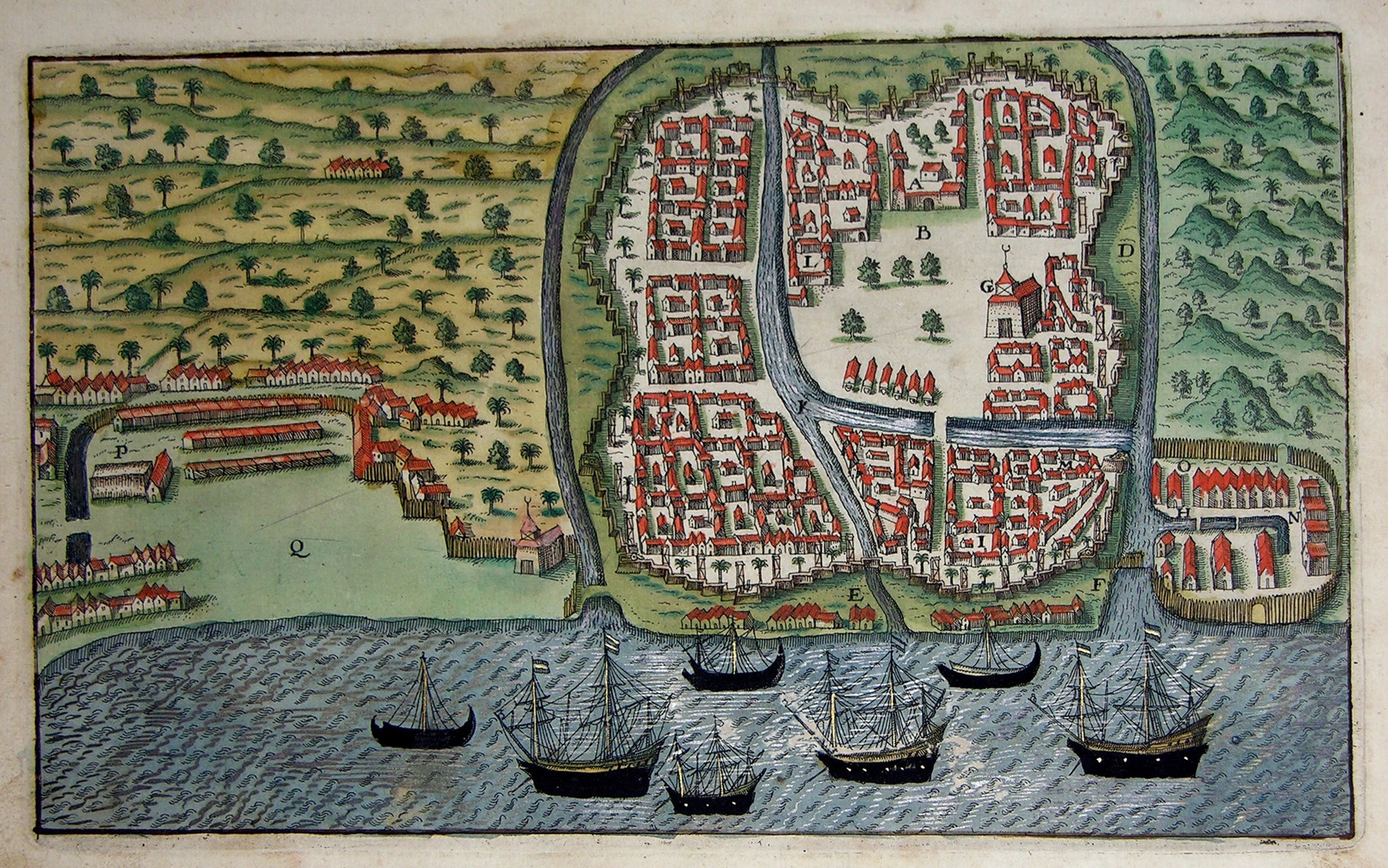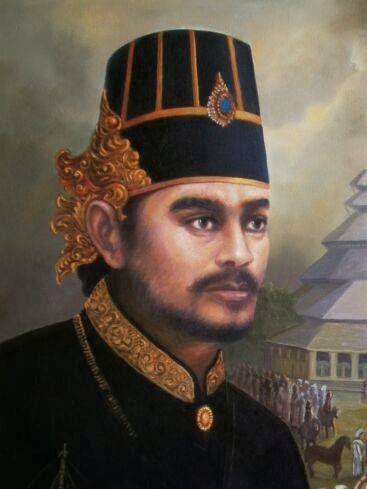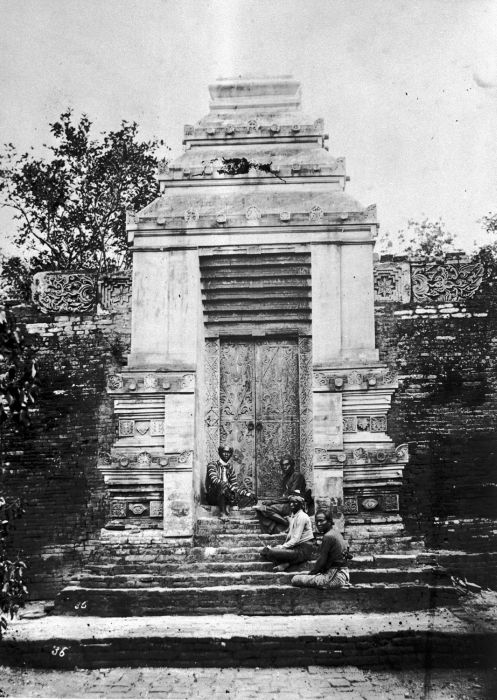|
Ageng
Tirtayasa (1631–1695), complete stylized name Sultan Ageng Tirtayasa, also known as Ageng and Abulfatah Agung, was the sixth sultan of Banten (on Java in modern Indonesia) and reigned during the kingdom's golden age. Overview Ageng built a strong fleet on European models, which did considerable trade within the Indonesian archipelago, and, with help from the English, Danes, and Chinese, were able to trade with Persia, India, Siam, Vietnam, China, the Philippines, and Japan in the Javanese tradition of long-distance traders. This trade gave considerable wealth to Banten, the greatest period for which was arguably under Sultan Ageng Tirtayasa. In 1661 Ageng extended Banten rule to Landak in western Borneo. In the 1670s he also acquired Cirebon area following civil war in Mataram. Ageng established trade with Spanish Manila for silver and built canal for coconut palm and sugar plantations, among other developments. Principal activities Conflict with the Dutch Ageng was a strong ... [...More Info...] [...Related Items...] OR: [Wikipedia] [Google] [Baidu] |
Sultan Of Banten
The Banten Sultanate (كسلطانن بنتن) was a Bantenese people, Bantenese Islamic trading sultanate, kingdom founded in the 16th century and centred in Bantam (city), Banten, a port city on the northwest coast of Java; the contemporary English name of both was Bantam. It is said to have been founded by Sunan Gunungjati, who had previously founded Cirebon. Once a great trading centre in Southeast Asia, especially of Black pepper, pepper, the kingdom reached its apogee in the late 16th and mid-17th centuries. By the late 17th century its importance was overshadowed by Batavia, Dutch East Indies, Batavia, and finally annexed to Dutch East Indies in 1813. Its core territory now forms the Provinces of Indonesia, Indonesian province of Banten. Today, in Old Banten, the Great Mosque of Banten is an important destination for tourists and for pilgrims from across Indonesia and from overseas. Formation Before 1526 CE, a settlement called Banten was situated about ten kilometres i ... [...More Info...] [...Related Items...] OR: [Wikipedia] [Google] [Baidu] |
Banten Sultanate
The Banten Sultanate (كسلطانن بنتن) was a Bantenese Islamic trading kingdom founded in the 16th century and centred in Banten, a port city on the northwest coast of Java; the contemporary English name of both was Bantam. It is said to have been founded by Sunan Gunungjati, who had previously founded Cirebon. Once a great trading centre in Southeast Asia, especially of pepper, the kingdom reached its apogee in the late 16th and mid-17th centuries. By the late 17th century its importance was overshadowed by Batavia, and finally annexed to Dutch East Indies in 1813. Its core territory now forms the Indonesian province of Banten. Today, in Old Banten, the Great Mosque of Banten is an important destination for tourists and for pilgrims from across Indonesia and from overseas. Formation Before 1526 CE, a settlement called Banten was situated about ten kilometres inland from the coast on the Cibanten River, in the area which is today occupied by the southern suburbs of ... [...More Info...] [...Related Items...] OR: [Wikipedia] [Google] [Baidu] |
Haji Of Banten
Abu Nasr Abdul Kahhar (also known as Sultan Haji or Haji of Banten) was the seventh Sultan of Banten from 1682 to 1687, who was largely responsible for subjugating Banten to the Dutch East India Company (VOC). He had considerable political power as a crown prince, and from the 1650s the court was divided into factions in support of his father Ageng and him. The VOC even called them the "old Sultan" and "young Sultan," respectively. Haji's faction was in favor of a stronger relationship with the VOC in nearby Batavia, while Ageng was a firm opponent of such a relationship. Haji's faction gained the upper hand in May 1680, just as Ageng had Batavia surrounded and was declaring war on the Dutch. His father had a decade earlier withdrawn to a residence outside Banten proper, but Haji led a coup and confined Ageng to his residence outside the city. His position was weak, however, because he lacked the support of the Muslim elite, who remained loyal to his father, and who resented his ov ... [...More Info...] [...Related Items...] OR: [Wikipedia] [Google] [Baidu] |
List Of Sultans Of Banten
The Sultan of Banten was the ruler of Banten Sultanate in the province of Banten Banten ( id, Banten; Sundanese: , romanized ''Banten'') is the westernmost province on the island of Java, Indonesia. Its capital city is Serang. The province borders West Java and the Special Capital Region of Jakarta on the east, the Java Se ..., Indonesia, which had triumphed at the western tip of Java island. The sultanate was founded by Maulana Hasanuddin of Banten who reigned between 1552 to 1570. It was one of the most important Muslim dynasties in pre-colonial Indonesia that made contact with the Europeans. List of Sultans of Banten * Sunan Gunungjati, Syarif Hidayatullah or ''Sunan Gunung Jati'' from Sultanate of Cirebon # Maulana Hasanuddin of Banten, Sultan Maulana Hasanuddin or ''Prince Sabakinking'' 1552–1570 # Maulana Yusuf of Banten, Sultan Maulana Yusuf or ''Prince Pasareyan'' 1570–1585 # Maulana Muhammad of Banten, Sultan Maulana Muhammad or ''Prince Sedangrana'' 1585� ... [...More Info...] [...Related Items...] OR: [Wikipedia] [Google] [Baidu] |
Sultanate Of Mataram
The Sultanate of Mataram () was the last major independent Javanese kingdom on the island of Java before it was colonised by the Dutch. It was the dominant political force radiating from the interior of Central Java from the late 16th century until the beginning of the 18th century. Mataram reached its peak of power during the reign of Sultan Agung Anyokrokusumo (), and began to decline after his death in 1645. By the mid-18th century, Mataram lost both power and territory to the Dutch East India Company (Dutch: ''Vereenigde Oost-Indische Compagnie''; ''VOC''). It had become a vassal state of the company by 1749. Etymology The name ''Mataram'' itself was never the official name of any polity, as the Javanese often refer to their realm simply as ''Bhumi Jawa'' or ''Tanah Jawi'' ("Land of Java"). ''Mataram'' refers to the historical areas of plains south of Mount Merapi around present-day Muntilan, Sleman, Yogyakarta, and Prambanan. More precisely, it refers to the Kota Gede ... [...More Info...] [...Related Items...] OR: [Wikipedia] [Google] [Baidu] |
Mataram Sultanate
The Sultanate of Mataram () was the last major independent Javanese kingdom on the island of Java before it was colonised by the Dutch. It was the dominant political force radiating from the interior of Central Java from the late 16th century until the beginning of the 18th century. Mataram reached its peak of power during the reign of Sultan Agung Anyokrokusumo (), and began to decline after his death in 1645. By the mid-18th century, Mataram lost both power and territory to the Dutch East India Company (Dutch: ''Vereenigde Oost-Indische Compagnie''; ''VOC''). It had become a vassal state of the company by 1749. Etymology The name ''Mataram'' itself was never the official name of any polity, as the Javanese often refer to their realm simply as ''Bhumi Jawa'' or ''Tanah Jawi'' ("Land of Java"). ''Mataram'' refers to the historical areas of plains south of Mount Merapi around present-day Muntilan, Sleman, Yogyakarta, and Prambanan. More precisely, it refers to the Kota Gede ... [...More Info...] [...Related Items...] OR: [Wikipedia] [Google] [Baidu] |
Old Banten
Old Banten (Indonesian ''Banten Lama'') is an archaeological site in the northern coast of Serang Regency, Banten Province, Banten, Indonesia. Located 11 km north of Serang city, the site of Old Banten contains the ruin of the walled port city of Banten (town), Banten, the 16th-century capital of the Sultanate of Banten. Since 1995, Old Banten has been proposed to UNESCO World Heritage. History Banten was a 16th-century port city known for its pepper. The city flourished when the Islamic Banten Sultanate reached its peak during the 17th century. There was a period of intense conflicts with the Dutch East India Company (VOC) over the trade of spices, which eventually led to the dissolution of the Sultanate in Banten and to the city's decline. Today, the site where the city of Banten remains is known as Old Banten. It is a well-known tourist attraction, where many locals visit to pay their ziarah, respects and pray at the graves of Sultan Maulana Hasanuddin of Banten, Maulana ... [...More Info...] [...Related Items...] OR: [Wikipedia] [Google] [Baidu] |
Japan
Japan ( ja, 日本, or , and formally , ''Nihonkoku'') is an island country in East Asia. It is situated in the northwest Pacific Ocean, and is bordered on the west by the Sea of Japan, while extending from the Sea of Okhotsk in the north toward the East China Sea, Philippine Sea, and Taiwan in the south. Japan is a part of the Ring of Fire, and spans Japanese archipelago, an archipelago of List of islands of Japan, 6852 islands covering ; the five main islands are Hokkaido, Honshu (the "mainland"), Shikoku, Kyushu, and Okinawa Island, Okinawa. Tokyo is the Capital of Japan, nation's capital and largest city, followed by Yokohama, Osaka, Nagoya, Sapporo, Fukuoka, Kobe, and Kyoto. Japan is the List of countries and dependencies by population, eleventh most populous country in the world, as well as one of the List of countries and dependencies by population density, most densely populated and Urbanization by country, urbanized. About three-fourths of Geography of Japan, the c ... [...More Info...] [...Related Items...] OR: [Wikipedia] [Google] [Baidu] |
Trunajaya Rebellion
The Trunajaya rebellion (also spelled Trunojoyo; id, Pemberontakan Trunajaya) or Trunajaya War was the ultimately unsuccessful rebellion waged by the Madurese prince Trunajaya and fighters from Makassar against the Mataram Sultanate and its Dutch East India Company (VOC) supporters in Java (in modern-day Indonesia) during the 1670s. The rebellion was initially successful: the rebels defeated the royal army at Gegodog (1676), captured most of the Javanese north coast, and took the Mataram capital Plered (1677). King Amangkurat I died during the retreat of the royal court. His son and successor, Amangkurat II, requested help from the VOC in exchange for financial remuneration and geopolitical concessions. The VOC's subsequent involvement turned the tide of the war. VOC and Mataram forces expelled Trunajaya from Surabaya, recovered lost territories and overran his new capital at Kediri (1678). However, the rebellion continued until the capture of Trunajaya at the end of 167 ... [...More Info...] [...Related Items...] OR: [Wikipedia] [Google] [Baidu] |
Trunajaya
Trunajaya (Madurese) or Tronajâyâ, also known as Panembahan Maduretno (1649 – 2 January 1680), was a prince and warlord from Arosbaya, Bangkalan, Madura, known for leading the Trunajaya rebellion (1674–1681) against the rulers of the Mataram Sultanate on the island of Java. Rebellion Trunajaya was born in Madura. In 1674 he led a revolt against Amangkurat I and Amangkurat II of Mataram. He was supported by itinerant fighters from Makassar led by Karaeng Galesong. The Trunajaya rebellion moved swiftly and gained momentum, and captured the Mataram court at Plered in mid-1677. The Mataram king, Amangkurat I, escaped to the north coast with his eldest son, the future king Amangkurat II, leaving his younger son ''Pangeran'' (Prince) Puger in Mataram. Apparently more interested in profit and revenge than in running a struggling empire, the rebel Trunajaya looted the court and withdrew to his stronghold in Kediri, East Java, leaving Prince Puger in control of a weak court. ... [...More Info...] [...Related Items...] OR: [Wikipedia] [Google] [Baidu] |
Jakarta
Jakarta (; , bew, Jakarte), officially the Special Capital Region of Jakarta ( id, Daerah Khusus Ibukota Jakarta) is the capital and largest city of Indonesia. Lying on the northwest coast of Java, the world's most populous island, Jakarta is the largest city in Southeast Asia and serves as the diplomatic capital of ASEAN. The city is the economic, cultural, and political centre of Indonesia. It possesses a province-level status and has a population of 10,609,681 as of mid 2021.Badan Pusat Statistik, Jakarta, 2022. Although Jakarta extends over only , and thus has the smallest area of any Indonesian province, its metropolitan area covers , which includes the satellite cities Bogor, Depok, Tangerang, South Tangerang, and Bekasi, and has an estimated population of 35 million , making it the largest urban area in Indonesia and the second-largest in the world (after Tokyo). Jakarta ranks first among the Indonesian provinces in human development index. Jakarta's busin ... [...More Info...] [...Related Items...] OR: [Wikipedia] [Google] [Baidu] |
Dutch East India Company
The United East India Company ( nl, Verenigde Oostindische Compagnie, the VOC) was a chartered company established on the 20th March 1602 by the States General of the Netherlands amalgamating existing companies into the first joint-stock company in the world, granting it a 21-year monopoly to carry out trade activities in Asia. Shares in the company could be bought by any resident of the United Provinces and then subsequently bought and sold in open-air secondary markets (one of which became the Amsterdam Stock Exchange). It is sometimes considered to have been the first multinational corporation. It was a powerful company, possessing quasi-governmental powers, including the ability to wage war, imprison and execute convicts, negotiate treaties, strike its own coins, and establish colonies. They are also known for their international slave trade. Statistically, the VOC eclipsed all of its rivals in the Asia trade. Between 1602 and 1796 the VOC sent almost a million Eur ... [...More Info...] [...Related Items...] OR: [Wikipedia] [Google] [Baidu] |




%2C_Hoorn.jpg)